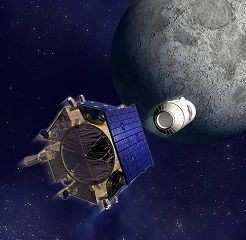Students Worldwide Will Help Track LCROSS Spacecraft
 In an unprecedented scientific
collaboration with a public school, the Lewis Center for
Educational Research will team with NASA to lead students worldwide
in tracking and monitoring a NASA lunar mission scheduled for
launch in early 2009. The collaboration will provide a unique
opportunity for students to become active participants in the NASA
lunar mission, as the space agency looks to inspire the next
generation of US space explorers and scientists.
In an unprecedented scientific
collaboration with a public school, the Lewis Center for
Educational Research will team with NASA to lead students worldwide
in tracking and monitoring a NASA lunar mission scheduled for
launch in early 2009. The collaboration will provide a unique
opportunity for students to become active participants in the NASA
lunar mission, as the space agency looks to inspire the next
generation of US space explorers and scientists.
NASA Ames Research Center and prime contractor Northrop Grumman
are spearheading the design and development of the Lunar CRater
Observation and Sensing Satellite (LCROSS) -- NASA's first major
lunar mission in decades -- to determine whether there is water on
the moon.
Students at the Lewis Center will monitor the spacecraft from
their Mission Control, on the Lewis Center campus, by controlling a
110-foot-diameter radio-antenna in Southern California's Mojave
Desert. Teachers and students around the world, including
home-schooled children, will have the same opportunity to
participate in the mission through the Lewis Center's Goldstone
Apple Valley Radio Telescope (GAVRT) Program -- a partnership
between the Lewis Center and NASA's Jet Propulsion Laboratory.
During the LCROSS mission, which will last several months,
participating students will help monitor the health and status of
the spacecraft by tracking its signal. If it is present during
times when the signal is not supposed to be transmitting, the
students can report back to LCROSS mission operations, potentially
revealing a problem with the spacecraft. That additional monitoring
beyond the coverage provided by NASA's Deep Space Network could
prove to be critical.
"Millions of us watched as man took his first step on the moon
back in 1969, but today's students will be active participants in
the first major lunar visit in the information age," said Rick
Piercy, President and CEO of the Lewis Center, which operates two
charter schools in San Bernardino County, California. "We are
excited that we will be leading students around the world as we
work with NASA and Northrop Grumman scientists on this pioneering
effort that will help rekindle the flame of space exploration in
America."
"The combined launch of LCROSS and the Lunar Reconnaissance
Orbiter (LRO) is NASA's most ambitious mission to the moon since
the Apollo era," said Daniel Andrews, NASA LCROSS Project Manager.
"It marks the first step in America's long-term commitment to space
exploration, with the ultimate goal of setting up outposts on the
moon, setting the stage for a manned mission to other planets. We
believe that actively engaging students in the LCROSS mission will
inspire today's students to become the scientists and astronauts of
tomorrow who will design and fly those missions."
NASA plans to launch the mission to look for water-ice on the
moon in early 2009, with the satellite directing an impactor to a
crater on one of the lunar poles. Scientists will analyze the
debris in the plume that will result when the impactor -- with the
mass of an SUV vehicle -- hurtles into the moon.
The Lewis Center for Educational Research, based in the Mojave
Desert in Southern California, operates two public charter schools,
including the innovative Academy for Academic Excellence. The Lewis
Center is the only K-12 school organization in the country to
control day-to-day operations of a large NASA radio telescope.
 ANN's Daily Aero-Linx (04.13.24)
ANN's Daily Aero-Linx (04.13.24) ANN's Daily Aero-Term (04.13.24): Beyond Visual Line Of Sight (BVLOS)
ANN's Daily Aero-Term (04.13.24): Beyond Visual Line Of Sight (BVLOS) Airborne 04.09.24: SnF24!, Piper-DeltaHawk!, Fisher Update, Junkers
Airborne 04.09.24: SnF24!, Piper-DeltaHawk!, Fisher Update, Junkers Aero-News: Quote of the Day (04.14.24)
Aero-News: Quote of the Day (04.14.24) ANN's Daily Aero-Term (04.14.24): Maximum Authorized Altitude
ANN's Daily Aero-Term (04.14.24): Maximum Authorized Altitude



